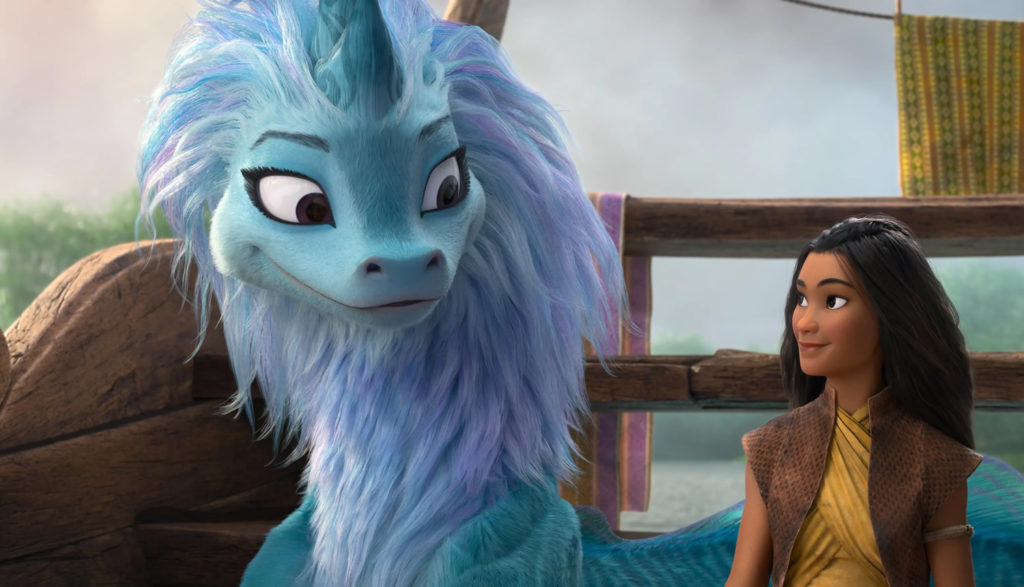
How did this world get so broken? This is what Raya wonders.
Hundreds of years ago, magical dragons used to reside in the land of Kumandra, bringing rain, water and peace to its people. But the people didn’t understand how to live in harmony. And the more their discord grew, the more an evil force, known as the Droon, fed upon their disunity.
The dragons did all they could to stop the monstrous Droon—which roamed the land as monstrous purple-black clouds of evil—from taking over and turning people into stone. But the only way to truly stop the Droon’s power was for the dragons to sacrifice their own lives and give their power, in the form of a magical gem, to one dragon to hold: Sisu.
Now, 500 years later, the story of Sisu is but a legend and the formerly peaceful Kumandra lies in ruins. The land is divided into five nations: Heart, Spine, Fang, Talon and Tail. And Heart is where Sisu’s magical gem, and Raya, live.
See, the people of Heart were tasked with guarding the magical gem, and so preventing the return of the Droon. But others don’t see it quite the same way. In fact, they believe that Heart is a thriving land because they have the magical gem. And they want a piece of it too.
One day, Raya’s father invites the people of Kumandra to share a meal in the hope that his hospitality will bring about much-needed unity. Young Raya follows his lead and invites the daughter of the land of Fang, Namaari, to see the magical gem.
But this act of kindness costs her everything.
Namaari betrays Raya’s trust and signals for her people to come and take what they believe is rightfully theirs. In mere moments, every royal member of Kumandra floods in and tries to steal the magical gem. But it’s dropped. And as it breaks into pieces, the Droon return, turning thousands into stone, including Raya’s father.
Six years later and Raya is on her own, embarking on a journey to find a way to bring her father back and to heal Kumandra. The only way to do this is to find the magical dragon, Sisu.
Most believe Sisu is only a myth. But Raya will stop at nothing to find her. And Namaari will do everything she can to make sure that doesn’t happen.
Raya’s father is loving, patient and wise. He teaches Raya that extending open arms to a perceived enemy is the way to mend brokenness and restore unity. He prepares a meal for the people of Kumandra to share and tells Raya that this is how they’re going to understand their enemies—by sitting at the same table and interacting instead of assuming the worst about them.
Raya, for her part, loves her father and initially works to be kind and compassionate, until she’s betrayed. Throughout the film, Raya unlearns many behaviors and thought patterns she’s adopted in the name of survival. She is a kind, brave and protective young woman.
Namaari shares many similar traits as Raya, although we only see them in glimpses, until the end. It’s clear that Namaari has also been deeply wounded and acts out of her woundedness. When no one trusts her or believes in her, Sisu takes the first step in accepting Namaari, recognizing her pain and desiring to connect with the real her.
Sisu encourages Raya to trust others, to reconcile broken relationships and to extend love and forgiveness before suspicion or hate. She also teaches her how to be compassionate, to extend compassion and to be vulnerable. Sisu tells Raya that her own siblings believed in her, and that trust in her empowered Sisu beyond anything else.
In the end, the film tells us that trust is the key to mending a broken world. We also learn lessons of forgiveness, reconciliation, hope, perseverance and vulnerability through the lives of the characters.
The people of Kumandra worship the land’s magical dragons, demonstrating their reverence by forming a circle with their hands when they encounter a dragon or a dragon statue. We’re told that the magical dragons of Kumandra were responsible for bringing water, rain and peace to the land.
Raya makes an altar to Sisu and prays to her, asking that she restore Kumandra. Sisu tells Raya that every dragon has a unique magical ability.
Though the story here obviously isn’t a Christian one, the theme of sacrifice is present repeatedly. Families could easily use the story here as a bridge to talk about a passage such as John 15:13: “Greater love has no one than this: to lay down one’s life for one’s friends.”
Likewise, spiritual parallels could be drawn to how forgiveness and trust lead to new life—specifically those who’ve been turned to stone being brought back to life and, possibly, something like a resurrection for one character believed to be dead.
None, really, though male warriors from fang are shown shirtless.
The PG rating is most definitely for the scenes of mild peril, action and hand-to-hand combat. Raya’s father teaches her how to defend the magic gem, which includes learning to battle with swords and engage in close combat. Raya uses these skills throughout the film to defend herself and those she loves.
But Raya isn’t the only one who is taught how to fight. Her nemesis, Namaari, is a skilled warrior who uses fear to get what she wants, even threatening her guards and soldiers. She and her soldiers also ride on vicious cats.
The Droon, a gaseous, purple and black mass born of human discord, is an evil, powerful force that continues to grow the more disunity grows. The Droon envelope people and turning them to stone, leaving children orphaned and others without family. A corrupt elderly village leader sends Sisu out near the Droon with no protection.
A mighty warrior bluffs that he’s “formulating a gruesome plan” in his head for disposing of Raya and her friends. Many throughout the film are blinded by their own rage. A dragon is shot and apparently killed by a crossbow bolt. We learn that Raya and Namaari have both been raised by single parents, but we never learn what happened to the ones who are no longer around.
A warrior uses the term “butt kickery” and “bad axery.” Someone is called a “dung pot.”
None.
Raya struggles to trust after watching her father extend open arms to his enemies, only to be turned to stone. She’s also apprehensive of nearly everyone after being betrayed multiple times. At first, she truly believes that people are bad and that looking out for yourself is the only way to survive. But she isn’t alone, as almost everyone in the five warring nations are taught within their own communities to be suspicious of others.
Sisu observes that a beetle’s “booty” glows and Raya tells her it also “toots.” After Sisu magically shapeshifts into human form, she observes happily that her butt is far closer to her head than before. Also on this topic, we very briefly glimpse part of a baby’s bare backside as she sheds her own diaper to change into another.
Disney’s latest animated effort is a compelling, action-packed story and an allegory about how our brokenness separates us from each other.
As Raya strives to bring her father back to life, she also gradually learns that the only way restore Kumandra’s former unity is to do the hard work of forgiveness. And that will require believing and trusting in others even if most folks struggle to do so.
This is a message for today. A message for all of us. This movie teaches some truly valuable lessons, like how to work toward reconciliation and renew hope. And it also says, very clearly, that real love is when you lay down your life for another.
But we can’t wait for our neighbor to be the first to extend love and forgiveness. If we wait, we might be waiting forever. Instead, just as Jesus taught, we forgive because we have been forgiven. We model what we have been shown. To be clear, God is never mentioned in this film. But echoes of the gospel ring loud and true throughout many scenes.
Still, there are some things parents will want to be aware of here. The Droon, which apparently represent the flawed hearts of humanity, could be pretty scary for little viewers. And although parallels to Christianity can easily be identified throughout the story, parents need to know that the reverence afforded dragons and the magical world they live in are obviously drawn more from Chinese mythology. Finally, the film’s intense action, combat and perilous scenes may be a bit much at times for very young or sensitive viewers.
For everyone else, Raya and the Last Dragon potentially offers a rollicking, storytelling romp with some deeper teachable moments and spiritual lessons lying just below the surface.


Kristin Smith joined the Plugged In team in 2017. Formerly a Spanish and English teacher, Kristin loves reading literature and eating authentic Mexican tacos. She and her husband, Eddy, love raising their children Judah and Selah. Kristin also has a deep affection for coffee, music, her dog (Cali) and cat (Aslan).